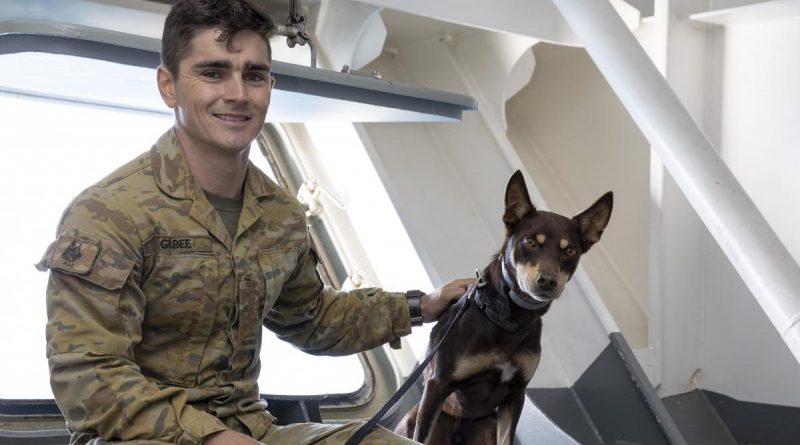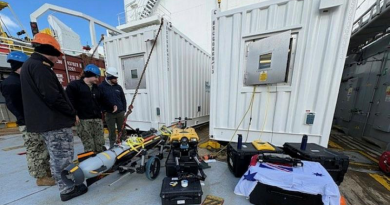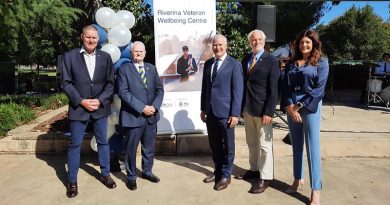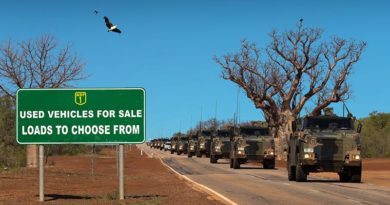Exercise Talisman Sabre 21 brings a new meaning to “Salty Sea Dogs”
Share the post "Exercise Talisman Sabre 21 brings a new meaning to “Salty Sea Dogs”"

Not to be outdone by their human handlers, even Australian Defence Force working dogs are finding their sea legs on board HMAS Canberra.
CAPTION: Australian Army Soldier Sapper Dalton Gilbee and Explosives Detection Dog Archie from 3rd Combat Engineering Regiment onboard HMAS Canberra, during Exercise Talisman Sabre 2021. Story by Captain Dan Mazurek. Photo by Leading Seaman Imagery Specialist Nadav Harel.
During Canberra’s lead-up exercise to Exercise Talisman Sabre 21 (TS21), police dogs from Alpha Company, 1 Military Police (MP) Battalion caused quite a stir wherever they strolled on ship.
MP soldiers attached to Canberra’s crew use the maritime exercises to practice inserting ashore via ship and aircraft. This includes K9 specialists Privates Alex Penfold, with German Shephard Bodie, and Beata Wawrzynowicz, with her Belgian Malinois Azura.
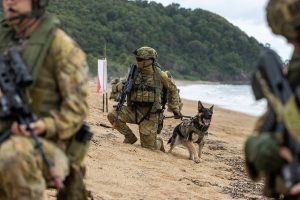
These MP K9 units offer a unique capability to support commanders once ashore. Bodie and Azura can deter potential adversaries, detect enemies in hiding and apprehend anyone foolish enough to run.
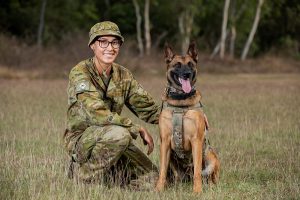
It’s a tight race for “favourite dog at sea”. Exercise SEA RAIDER, the maritime component to TS21, introduced Canberra to Explosive Detection Dog Archie and his handler Sapper Dalton Gulbee, from the Royal Australian Engineers.
Detection Dogs have very different roles to their MP counterparts. They are trained to search open areas, vehicles, routes and buildings and use their keen noses to detect a variety of explosives, ammunition and weapons.
The dogs typically live at home with their handlers, solidifying what is already a fair dinkum rock solid bond.
Sapper Gulbee laughs when asked if Archie, a four-year-old Kelpie, can also fill an intimidation or deterrence role in addition to his bomb detection duties.
“Nah, he’s harmless. Look at him!”
The most pressing question is obviously: how do dogs live on naval warships?
Typically, the pooches relieve themselves on the gun deck in a special area just for them. Either by hose or by small baggie, their handlers quickly clean up after them.
As for sleeping arrangements, Sapper Gulbee admits he’s definitely a “dog-on-the-bed” kind of guy.
“He sleeps on my bed! He does have a mat, but he’s decided that my bed is much more comfy, so usually we’re snuggled up nice and tight.”
“Out in the field we can’t carry a crate so if we’re out pack marching everywhere he’ll just sleep next to me, outside the bivvie bag.” For cold weather, Sapper Gulbee carries a small doggy coat but Archie has a simpler solution – he jumps right in.
To go ashore on mission takes a fair bit of preparation. The handlers carry all the food, extra water and equipment, like goggles, harnesses, special boots and first-aid kits that their furry colleagues might require.
Wherever they go, though, they garner an avalanche of pats, bickies and water, which illustrates one of the greatest advantages these dogs bring to the fight – morale.
Sapper Gulbee sees it firsthand on a daily basis.
“Everyone can be having the worst day ever and then they see the dog. [He] lifts everyone’s spirits.”
.
.

.
.
Share the post "Exercise Talisman Sabre 21 brings a new meaning to “Salty Sea Dogs”"

